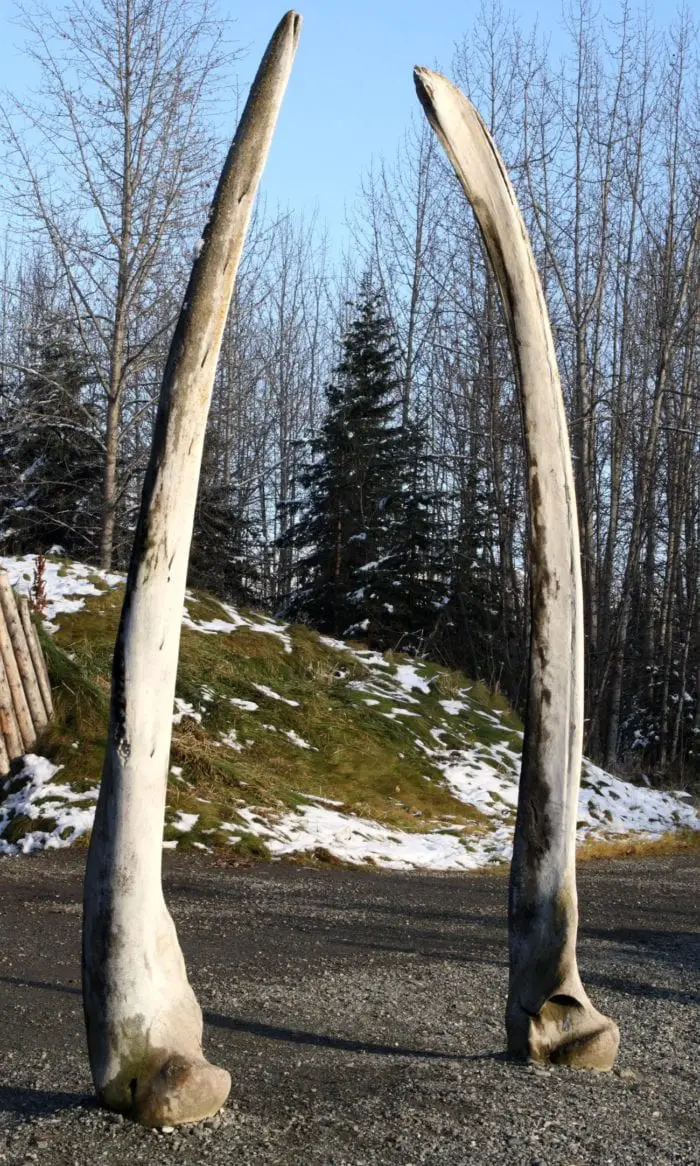It’s easy to get lost in the haunting sight of Whale Bone Alley. Since its discovery, the place occupies a rare space where fiction and reality seem to mingle, making the former plausible and spicing up the latter. Found by accident, the stretch of bones lining Yttygran Island emerged out of the fog as a boat passed by. Colossal whalebones vertically stuck in the ground beckoned the crew to the misty shore. They were there to uncover what some have dubbed the Siberian Stonehenge.
The story, in that respect, begins in 1976. The Institute of Ethnography of the Academy of Sciences of the USSR sent researchers on an expedition. Exploring the Chukotka coast, they didn’t sail with plans on discovering this lost location. While going through the Senyavin Strait, the fog cleared and revealed the macabre site. They could just as easily have sailed by the shrouded spectacle none the wiser. Instead, massive jawbones, ribs, and the vertebrae of whales appeared. Spread along the island, but not in any way naturally placed, researchers knew right away they were looking at something constructed.
Led by M. A. Chlenov, they ventured ashore. Exploring the site, it could only be called monumental in size. These macabre constructs easily dwarfed similar whalebone motifs at Indigenous settlements along the Chukchi Peninsula. Here researchers found parallel rows of skulls from bowhead whales arranged in groups of two or four. Amidst them, jawbones stuck vertically in the ground, each one towering above a person. The colossal skulls and jaws essentially lined the shore for approximately 550 meters. That’s roughly 1,804 feet of bones dotting the way to a ring of large boulders.
There the explorers discovered funnel-shaped pits lined with stones. Each went about 1 to 2 meters deep. Inside these 120 conical pits, remains of frozen meat and blubber suggested a storage area. Nearby structures described as having a “cultic character” appeared to be a part of the complex. However, researchers possessed little to compare them to. No ritual structure of this size exists anywhere else along the Asiatic Bering Strait. Indigenous oral traditions don’t even hint at the existence of a place like Whale Bone Alley.

When something passes beyond the recollection of folklore, the mystery becomes all the more enticing. Something like Whale Alley is not built to be lost. Whatever led to its disappearance from history is sure to tempt even the casually curious in the same way the heads of Easter Island demand at least a second glance. Speculation easily runs wild, and so many horror stories spring to mind given this familiar setup.
From H. P. Lovecraft’s At the Mountains of the Madness to the first Alien vs. Predator, The Ruins, Dominion: Prequel to the Exorcist, and the multitude of Mummy media, there’s that element of a place best left forgotten in the horror genre. The aesthetics of Whale Alley call to mind the strange horror western Bone Tomahawk or survival horror game The Forest. It’s not so much that humans have never used animal remains to build things before, but it’s that the scale here is unique. Whether ominous or awe-inspiring, the bones stir something in the soul. Add to it all that the diminutive Yttygran Island is uninhabited, and it’s the perfect mix of mystery and unsettling sights to fire the imagination.
To date, researchers are not entirely certain as to the site’s purpose. It could be place a of worship, a central location for tribal gatherings, or just a very ornate location for harvesting whale meat. In a certain respect, there’s no way to really know why Whale Bone Alley is there.
Granted, there may be mundane reasons for the existence of Whale Bone Alley. However, that speaks more to a sad lack of a better term, rather than anything disappointing. Even if it was merely a spot for whale hunters to gather and slice meat for storage, the visual character of the place is striking. Moreover, something like Whale Bone Alley isn’t constructed casually. It is believed to have been built 600 years ago, and someone didn’t simply get a hankering one afternoon to line the shore with bones then do it before nightfall. This place took time to complete, which speaks to an intention—it’s meant to mean something. And although we may not fully grasp that meaning today, a sacred quality pervades the atmosphere—one that can still speak to people, invoking all manner of thoughts.

Locations like Whale Bone Alley give us a glimpse of the time when human beings first began conceiving of reality beneath the surface, beyond the immediately apparent. This is when conceptions of the world started featuring elements of the unseen. Researchers studying prehistoric artifacts have stated the use of bones is, “an example of symbolic activity…indicative of the spiritual connection that the hunters had with the animals they killed.” As such, it’s not a stretch to perceive the bones on Yttygran Island having some deeper meaning.
Archaeology isn’t known for being the most dramatic of professions. Regardless of fictional representations, and with all due respect to Henry “Indiana” Jones Jr., it’s not exactly an exciting occupation. Most of the work involves digging in the dirt, bracing for disappointment. Pottery shards can only say so much about a culture, and many artifacts aren’t signs of fantastical events or realities. That is to say, not everything archeologists uncover speaks to the grandeur of existence. The Whale Bone Alley, however, stabs certain thoughts into the mind.

It’s hard not to look at the trail of bones without notions of mortality intruding. Looking at an immense skull, the smallness of humanity, literally and figuratively, comes to mind. In that respect, the Whale Bone Alley is a corridor to existential dread. Yet, at the same time, it’s a marvel of human accomplishment: something that was built centuries ago lasted and echoed throughout time. Being there, one potentially feels what another person did all those years ago walking between the bones gleaming fresh in the ground. In a way, that’s a means of experiencing the past.
If that intrigues, then fortunately it’s currently possible to book a trip to the site. Though with that said, Yttygran Island isn’t easy to get to. One route requires a plane ride from Russia’s easternmost town Anadyr. After landing in the village of Providenie, an off-road vehicle takes tourists down an 85km (52 miles) dirt road to another village, Yanrakynnot. Finally, a brief sea journey deposits a person on Yttygran Island.
It can seem like a lot to reach an island only 82km (50 miles) from Alaska. Granted, there are a few easier ways to arrive, but that wouldn’t be an adventure, and visiting Whale Bone Alley, experiencing the whole mystery almost requires the extra effort. After all, there’s nothing magical about a place one can pop in and out of. Furthermore, its remoteness almost feels like Whale Alley doesn’t want to be found.



